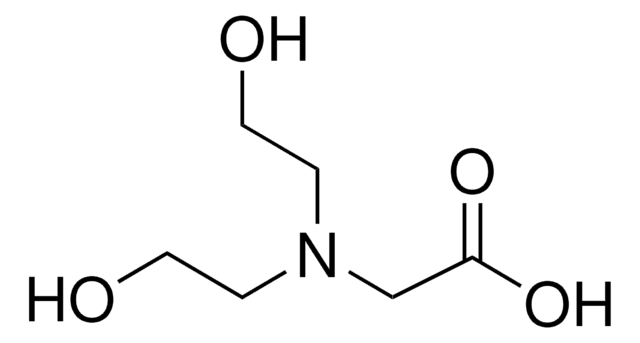모든 사진(5)
About This Item
Linear Formula:
(HOCH2)3CNHCH2CO2H
CAS Number:
Molecular Weight:
179.17
Beilstein:
1937804
EC Number:
MDL number:
UNSPSC 코드:
12161700
PubChem Substance ID:
NACRES:
NA.25
추천 제품
분석
≥99% (titration)
형태
crystalline powder
유용한 pH 범위
7.4-8.8
pKa(25 °C)
8.1
mp
187 °C
solubility
water: 0.25 g/mL, clear, colorless
응용 분야
diagnostic assay manufacturing
SMILES string
OCC(CO)(CO)NCC(O)=O
InChI
1S/C6H13NO5/c8-2-6(3-9,4-10)7-1-5(11)12/h7-10H,1-4H2,(H,11,12)
InChI key
SEQKRHFRPICQDD-UHFFFAOYSA-N
유사한 제품을 찾으십니까? 방문 제품 비교 안내
일반 설명
Tricine is the most frequently used electrophoresis buffer. It is also useful for the resuspension of cell pellets. Tricine functions as a trailing ion and aids the resolution of small proteins at lower acrylamide concentrations than in glycine-sodium dodecyl-sulfate polyacrylamide gel electrophoresis (SDS-PAGE) systems. It has a lower negative charge than glycine, which helps it migrate faster. Tricine has a high ionic strength that allows increased ion movement and less protein movement. This in turn leads to the separation of low molecular weight proteins in lower percent acrylamide gels.
애플리케이션
Tricine has been used:
- to prevent precipitation of salts during autoclaving of Emiliania huxleyi cultures
- as a component of buffer A for the homogenization of samples like Caenorhabditis elegans, Drosophila, and plants
- as a component of fresh assay buffer to measure serum melatonin by radioimmunoassay
Buffer component for separation of low molecular weight peptides.
Storage Class Code
11 - Combustible Solids
WGK
WGK 3
Flash Point (°F)
Not applicable
Flash Point (°C)
Not applicable
개인 보호 장비
Eyeshields, Gloves, type N95 (US)
시험 성적서(COA)
제품의 로트/배치 번호를 입력하여 시험 성적서(COA)을 검색하십시오. 로트 및 배치 번호는 제품 라벨에 있는 ‘로트’ 또는 ‘배치’라는 용어 뒤에서 찾을 수 있습니다.
이미 열람한 고객
Assessing the applicability of Emiliania huxleyi coccolith morphology as a sea-surface salinity proxy
Fielding SR, et al.
Limnology and Oceanography, 54(5), 1475-1480 (2009)
Hermann Schägger
Nature protocols, 1(1), 16-22 (2007-04-05)
Tricine-SDS-PAGE is commonly used to separate proteins in the mass range 1-100 kDa. It is the preferred electrophoretic system for the resolution of proteins smaller than 30 kDa. The concentrations of acrylamide used in the gels are lower than in
Arpita Gantayet et al.
Biofouling, 29(1), 77-85 (2012-12-06)
The freshwater zebra mussel (Dreissena polymorpha) is a notorious biofouling organism. It adheres to a variety of substrata underwater by means of a proteinaceous structure called the byssus, which consists of a number of threads with adhesive plaques at the
Christian Nilsson et al.
Electrophoresis, 31(3), 459-464 (2010-02-02)
Totally porous lipid-based liquid crystalline nanoparticles were used as pseudostationary phase for capillary electroseparation with LIF detection of proteins at physiological conditions using unmodified cyclic olefin copolymer capillaries (Topas, 6.7 cm effective length). In the absence of nanoparticles, i.e. in
Thierry Rabilloud
Journal of proteomics, 73(8), 1562-1572 (2010-04-17)
Electrophoretic separations of proteins are widely used in proteomic analyses, and rely heavily on SDS electrophoresis. This mode of separation is almost exclusively used when a single dimension separation is performed, and generally represents the second dimension of two-dimensional separations.
자사의 과학자팀은 생명 과학, 재료 과학, 화학 합성, 크로마토그래피, 분석 및 기타 많은 영역을 포함한 모든 과학 분야에 경험이 있습니다..
고객지원팀으로 연락바랍니다.




![N-[3-(2-Furyl)acryloyl]-Leu-Gly-Pro-Ala](/deepweb/assets/sigmaaldrich/product/structures/805/876/96b5fb57-71c8-4c6b-b5d2-fafe7374cd85/640/96b5fb57-71c8-4c6b-b5d2-fafe7374cd85.png)
